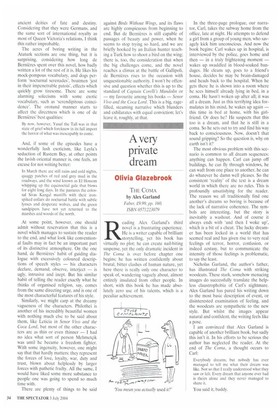Avery private dream
Olivia Glazebrook
THE COMA by Alex Garland Faber, £9.99, pp. 160, ISBN 0571223079 Reading Alex Garland's third novel is a frustrating experience. He is a writer capable of brilliant storytelling, yet his book has virtually no plot; he can create nail-biting suspense, yet the only dramatic incident in The Coma is over before chapter one begins; he has written confidently about brutal, bitter clashes of human nature, yet here there is really only one character to speak of, wandering vaguely about, almost entirely insulated from other people. In short, with this book he has made absolutely zero use of his talents, which is a peculiar achievement.
In the three-page prologue, our narrator, Carl, takes the subway home from the office, late at night. He attempts to defend a girl from a group of young men, who savagely kick him unconscious. And now the book begins: Carl wakes up in hospital, is interviewed by the police, goes home and then — in a truly frightening moment — wakes up swaddled in blood-soaked bandages. He cleans up, goes to a friend's house, decides he may be brain-damaged andheads back to the hospital. When he gets there he is shown into a room where he sees himself already lying in bed, in a coma. He hasn't woken up after all; it was all a dream. Just as this terrifying idea formulates in his mind, he wakes up again — this time in bed at home, with his girlfriend. Or does he? He suspects that this too is a dream, and that he is still in a coma. So he sets out to try and find his way back to consciousness. Now, doesn't that sound gripping? So the question is, why on earth isn't it?
The most obvious problem with this scenario is common to all dream sequences: anything can happen. Carl can jump off buildings, he can fly through windows, he can waft from one place to another, he can do whatever he damn well pleases. So the consistent 'reality' of the text is a dream world in which there are no rules. This is profoundly unsatisfying for the reader. The reason we all traditionally find one another's dreams so boring is because of the lack of narrative coherence. The symbols are interesting, but the story is inevitably a washout. And of course it always ends with 'and then I woke up', which is a bit of a cheat. The lucky dreamer has been locked in a world that has seemed real and has given rise to very real feelings of terror, horror, confusion, or indeed ecstasy, but to communicate the intensity of those feelings is problematic, to say the least.
Nicholas Garland, the author's father, has illustrated The Coma with striking woodcuts. These stark, somehow menacing images do successfully translate the helpless claustrophobia of Carl's nightmare. Alex Garland has pared his writing down to the most basic description of event, or disinterested examination of feeling, and the woodcuts are sympathetic to the new style. But whilst the images appear natural and confident, the writing feels like a pose.
I am convinced that Alex Garland is capable of another brilliant book, but sadly this isn't it. In his efforts to be serious the author has neglected the reader. At the end of The Coma, a thought occurs to Carl:
Everybody dreams, but nobody has ever managed to tell me what their dream was like. Not so that I really understood what they saw or felt. Every dream that anyone ever had is theirs alone and they never managed to share it.
You said it, buddy.


































































 Previous page
Previous page